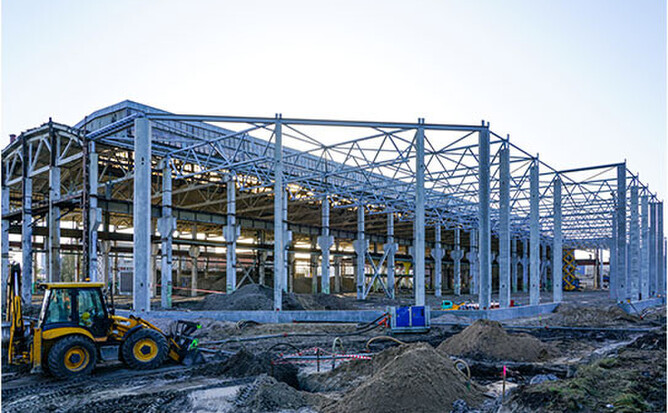Warehouses must support high efficiency, durability, and cost-effective operations. Choosing the right warehouse construction types impacts storage capacity, logistics, and overall business performance. Different methods suit various industries, budgets, and locations, each offering unique benefits. Some focus on speed, while others enhance insulation, security, or scalability. Materials, design, and structure influence how well a facility meets operational demands. Selecting the most suitable option increases workflow efficiency, reduces maintenance costs, and extends the building’s lifespan.
Here are the most effective warehouse construction types that improve functionality and long-term value.
Pre-Engineered Metal Buildings for Faster Assembly
Pre-engineered metal buildings use prefabricated components assembled on-site. This method speeds up construction since structural elements arrive ready for installation. Factory-controlled production reduces material waste and ensures consistency in quality. Lighter steel frames reduce foundation requirements, lowering costs while maintaining strength. Pre-engineered designs also include expansion options, making it easy to add sections as business needs grow.
Metal buildings resist harsh weather, fire, and pests, increasing longevity with minimal upkeep. Their modular design allows fast installation, making them ideal for warehouses that need quick deployment. Large clear-span interiors provide unobstructed storage space, supporting efficient workflow. Prefabrication streamlines construction, reducing labor costs and delays.
Tilt-Up Concrete Warehouses for Cost-Effective Strength
Tilt-up concrete construction uses large panels poured on-site and lifted into position. This method delivers a strong and durable warehouse with lower material and maintenance costs. Concrete walls offer natural insulation, reducing energy expenses for climate-controlled storage. High resistance to impact, fire, and weather damage ensures longevity with minimal structural repairs.
Tilt-up panels allow flexible floor plans, accommodating both large open spaces and segmented storage areas. Construction requires fewer materials and less skilled labor than traditional masonry, lowering project costs. The process moves quickly, as panels cure on-site while other preparations continue. Once lifted into place, they form a strong, low-maintenance structure suited for heavy-duty warehouse operations.
Clear-Span Steel Structures for Unobstructed Space
Clear-span steel buildings use rigid frames without interior support columns, maximizing open floor space. These structures suit warehouses handling large inventory or requiring efficient movement of goods. With no columns, forklift navigation and shelving layout remain flexible, improving storage efficiency. Steel frames withstand heavy loads and seismic activity, ensuring durability.
Fabrication and installation move quickly, reducing construction time. Prefabricated steel components fit together precisely, lowering labor costs and minimizing material waste. Galvanized steel resists corrosion, extending the warehouse’s lifespan with minimal maintenance. Clear-span structures work well for distribution centers, fulfillment warehouses, and bulk storage facilities requiring open layouts.
Multi-Level Warehouses for Vertical Storage Optimization
Multi-level warehouses increase storage capacity without expanding the building footprint. These structures optimize land use, especially in urban areas where space is limited. Mezzanine floors and vertical racking systems create separate levels for inventory, reducing ground-level congestion. This design improves organization, accessibility, and order fulfillment speed.
Structural reinforcements support higher load capacities, allowing safe stacking of heavy goods. Elevators, conveyor systems, and automated storage solutions enhance efficiency. Multi-level designs work well for e-commerce fulfillment centers and high-density storage operations requiring compact yet functional warehouse space.
Insulated Panel Construction for Temperature Control
Insulated panel warehouses maintain stable interior temperatures, making them ideal for cold storage and climate-sensitive inventory. These structures use prefabricated panels with high thermal resistance, reducing energy costs for heating and cooling. Tight seals prevent moisture infiltration, protecting perishable goods from humidity damage.
Quick assembly reduces construction time, as panels arrive pre-finished and ready for installation. Strong, lightweight materials provide durability without excessive weight, minimizing foundation requirements. These warehouses work well for pharmaceutical storage, food distribution, and any facility requiring strict temperature regulation.
Hybrid Concrete and Steel for Structural Durability
Hybrid concrete and steel warehouses combine the strength of concrete with the flexibility of steel. This construction method enhances durability while allowing for adaptable designs. Concrete walls provide fire resistance, soundproofing, and structural integrity, while steel framing reduces weight and speeds up assembly. This combination works well for warehouses requiring heavy load-bearing capacity and long-term stability. The blend of materials creates a cost-effective solution that withstands harsh environmental conditions without excessive maintenance.
Hybrid structures offer design flexibility, accommodating open spaces, multi-level storage, and specialized layouts. Concrete walls protect against impact damage, while steel components support wide roof spans without interior obstructions. This approach suits distribution centers, manufacturing facilities, and industrial storage spaces that require a balance of strength and efficiency. The durability of hybrid designs extends warehouse lifespan while keeping construction costs manageable.
Fabric-Covered Warehouses for Temporary Storage Needs
Fabric-covered warehouses use lightweight steel frames and tensioned fabric membranes for rapid deployment. This design works well for temporary storage needs, seasonal inventory overflow, and emergency response operations. The fabric material allows natural light to filter through, reducing artificial lighting costs. Quick installation speeds up project timelines, making these warehouses a cost-effective solution for businesses needing immediate storage space.
The flexibility of fabric structures allows easy relocation or expansion. The steel frame ensures structural stability, while the durable fabric withstands harsh weather. These warehouses suit agricultural storage, construction material yards, and short-term supply chain operations. Their modular design makes them an efficient choice for businesses needing adaptable storage solutions without permanent construction.
Cold Storage Facilities for Perishable Goods Protection
Cold storage warehouses maintain strict temperature control to protect perishable goods. These facilities use insulated panel construction, advanced refrigeration systems, and humidity control to prevent spoilage. Proper temperature regulation ensures food products, pharmaceuticals, and sensitive materials remain safe during storage and distribution. High-efficiency insulation minimizes energy consumption, reducing operational costs while maintaining a stable environment.
Reinforced flooring supports heavy refrigeration units and storage racks. Door seals and airflow systems prevent temperature fluctuations, ensuring product integrity. These warehouses suit industries that handle frozen foods, medical supplies, and chemical storage. Cold storage designs also integrate automated inventory tracking and climate monitoring systems for precise control. Facilities remain operational year-round, ensuring businesses maintain a reliable supply chain without product loss.
High Bay Warehouses for Automated Storage Solutions
High bay warehouses maximize vertical storage with automated retrieval systems. These facilities use tall racking, robotic picking systems, and conveyor belts to improve efficiency. Businesses handling large inventories benefit from reduced labor costs and faster order fulfillment. High ceilings accommodate multi-tiered shelving, optimizing storage density within a compact footprint. Automated storage and retrieval systems (ASRS) eliminate manual errors and improve warehouse organization.
Structural reinforcements support heavy pallet loads at extreme heights. Lighting and ventilation systems adapt to high bay environments, ensuring energy efficiency. These warehouses suit e-commerce, retail distribution, and logistics centers that process large volumes of goods. High bay designs integrate with warehouse management software, streamlining inventory tracking and space utilization. The combination of automation and vertical storage maximizes efficiency for businesses requiring rapid order processing.
Maximize Efficiency with PE Builders – Your Experts in Warehouse Construction
Every project demands a construction method that meets operational needs and long-term durability. Our Industrial Construction Services in NY deliver strong, efficient warehouse solutions built for performance. From steel-framed structures to insulated cold storage, we create spaces that enhance logistics and storage capabilities. Our team builds with precision, ensuring that every warehouse supports seamless workflow and lasting durability.
Our Custom Warehouse Contractors in NY design and construct tailored solutions for businesses requiring specialized storage. Whether it’s high bay automation or multi-level optimization, we develop warehouses that maximize capacity without compromising efficiency. PE Builders combines industry expertise with cutting-edge techniques to bring reliable, cost-effective warehouses to life. Contact PE Builders today to discuss the best construction approach for your project. Call or text us to get started.

